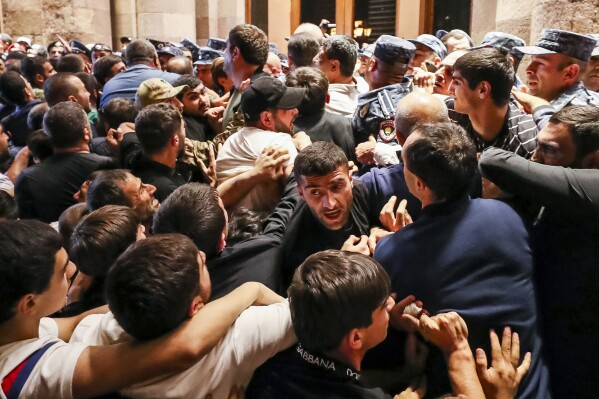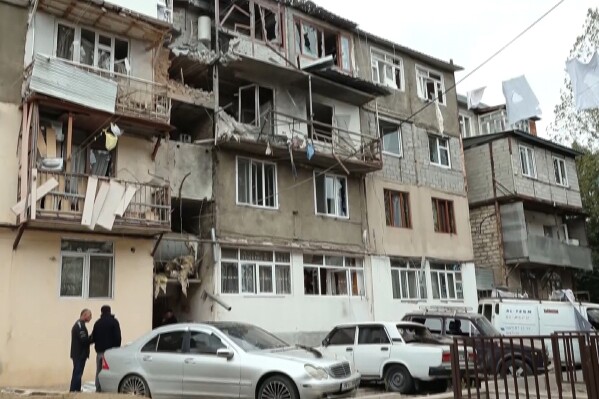Azerbaijan and Armenia fight for 2nd day over the breakaway region of Nagorno-Karabakh
YEREVAN, Armenia (AP) — Explosions rocked parts of Nagorno-Karabakh early Wednesday, a day after Azerbaijani forces used heavy artillery fire on Armenian positions in the separatist region that local officials said killed or wounded scores of people.
Azerbaijan has called the artillery fire an “anti-terrorist operation” and said it will continue until the separatist government of Nagorno-Karabakh dismantles itself and “illegal Armenian military formations” surrender.
It said it is only targeting military sites, but significant damage was visible on the streets of the regional capital, Stepanakert, with shop windows blown out and vehicles punctured apparently by shrapnel.
The blasts reverberated around Stepanakert every few minutes on Wednesday morning, with some explosions in the distance and others closer to the city.
 Why new fighting in troubled Azerbaijan region may herald a new war with Armenia
Why new fighting in troubled Azerbaijan region may herald a new war with Armenia
 European soccer could see more disruption from Azerbaijan-Armenia conflict over disputed region
European soccer could see more disruption from Azerbaijan-Armenia conflict over disputed region
 Fighting flares again in a breakaway region in the Caucasus Mountains
Fighting flares again in a breakaway region in the Caucasus Mountains
The artillery fire raised concerns that a full-scale war in the region could resume between Azerbaijan and Armenia, which for more than three decades have been locked in a struggle over the mountainous territory of Nagorno-Karabakh. The most recent heavy fighting there occurred over six weeks in 2020.
Azerbaijan’s Defense Ministry announced the start of the military operation hours after it reported that four soldiers and two civilians died in land mine explosions in Nagorno-Karabakh.
The ministry did not immediately give details but said that front-line positions and the military assets of Armenia’s armed forces were being “incapacitated using high-precision weapons,” and that only legitimate military targets were being attacked.
Armenia’s Foreign Ministry, however, denied that its weapons or troops were in Nagorno-Karabakh and called reported sabotage and land mines in the region “a lie.” Armenian Prime Minister Nikol Pashiyan alleged that Azerbaijan’s main goal is to draw Armenia into hostilities.
Ethnic Armenian officials in Nagorno-Karabakh said in a statement that Stepanakert and other villages were “under intense shelling.” The region’s military said Azerbaijan was using aircraft, artillery and missile systems, and drones in the fighting.
Residents of Stepanakert moved to basements and bomb shelters, and the fighting cut off electricity. Food shortages persisted in the area, with limited humanitarian aid delivered Monday not distributed due to the shelling, which resumed in the evening after halting briefly in the afternoon.
Nagorno-Karabakh human rights ombudsman Geghan Stepanyan said Tuesday that 27 people, including two civilians, were killed and more than 200 others were wounded. Stepanyan earlier said one child was among those killed, and 11 children were among the injured.
The Azerbaijani Prosecutor General’s Office said Armenian forces fired at Shusha, a city in Nagorno-Karabakh under Azerbaijan’s control, from large-caliber weapons, killing one civilian.
Neither claim could be independently verified.
Nagorno-Karabakh and sizable surrounding territories were under ethnic Armenian control since the 1994 end of a separatist war, but Azerbaijan regained the territories and parts of Nagorno-Karabakh during the 2020 fighting. That ended with an armistice placing Russian peacekeepers in Nagorno-Karabakh.
However, Azerbaijan alleges that Armenia has smuggled in weapons since then. The claims led to a blockade of the road connecting Nagorno-Karabakh to Armenia, causing food and medicine shortages.
Thousands of protesters gathered Tuesday in central Yerevan, the capital of Armenia, blocking streets and demanding that authorities defend Armenians in Nagorno-Karabakh. Some clashed with police, who reportedly used stun grenades. A total of 34 people — 16 policemen and 18 civilians — were injured in the clashes, Armenia’s Health Ministry said. About half of them continue to receive medical assistance, the ministry said.
___
Associated Press writers Jim Heintz va in Tallinn, Estonia; Aida Sultanova in London; and Siranush Sargsyan in Stepanakert contributed.
Disclaimer: The copyright of this article belongs to the original author. Reposting this article is solely for the purpose of information dissemination and does not constitute any investment advice. If there is any infringement, please contact us immediately. We will make corrections or deletions as necessary. Thank you.







